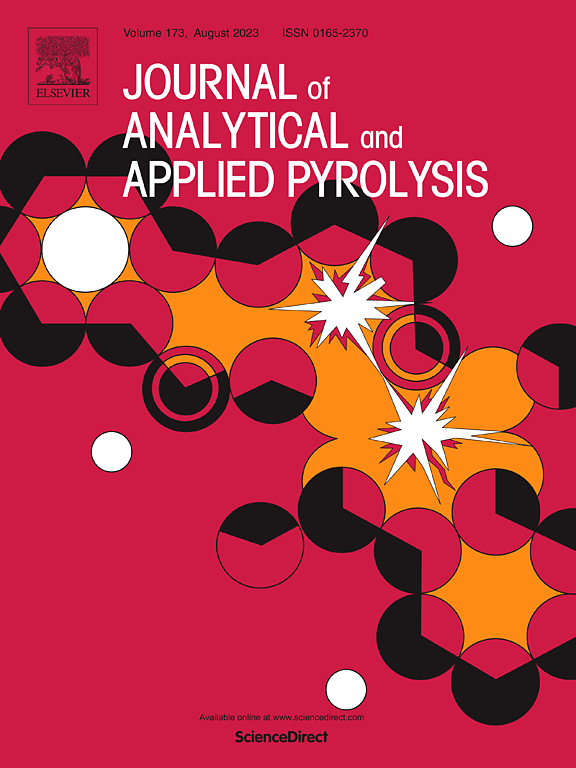聚醚醚酮热氧化行为的实验及ReaxFF MD研究
IF 5.8
2区 化学
Q1 CHEMISTRY, ANALYTICAL
引用次数: 0
摘要
聚醚醚酮(PEEK)是一种适用于各种工业应用的复合材料的热塑性基质。热处理是通过回收有价值的副产品来回收高性能工程塑料的一种很有前途的方法。本研究使用热重分析(TGA)和定制的热解-气相色谱/质谱(Py-GC/MS)系统来研究PEEK在氧化气氛下的热氧化行为。采用反应力场分子动力学(ReaxFF-MD)模拟研究其化学降解机理。TGA显示PEEK的初始降解发生在540°C以上,突出了其优异的热稳定性。氧气使降解温度降低了大约20°C,导致了一个明显的两阶段过程。值得注意的是,在500°C以下观察到化学结构的变化,这与ReaxFF-MD的发现一致,表明低聚物首先通过主链裂解形成。Py-GC/MS分析表明,PEEK热解生成了有价值的酚类化合物,主要是苯酚和对苯氧酚。主要氧化产物为二苯并呋喃,同时大量生成CO2/CO和H2O。Py-GC/MS和ReaxFF-MD结合表明,醚基和酮基首先发生裂解,末端苯羰基自由基比苯氧基自由基更容易断裂,导致CO释放提前。芳基自由基经过链裂解、抽氢和氢转移反应形成各种酚类物质。氧攻击主链形成•HO2和•OH自由基,随后通过加氢和氢脱氧与末端环反应。最终,开环反应将中间产物转化为CO2、CO和H2O。这些结果为PEEK的热氧化行为提供了见解,并提出了从废弃PEEK复合材料中回收高价值化学品的潜力。本文章由计算机程序翻译,如有差异,请以英文原文为准。
Experimental and ReaxFF MD study on the thermo-oxidative behavior of polyether ether ketone
Polyether ether ketone (PEEK) is a suitable thermoplastic matrix for composite materials in various industrial applications. Thermal treatment presents a promising approach for recycling high-performance engineering plastics through the recovery of valuable byproducts. This study investigated the thermo-oxidative behavior of PEEK using thermogravimetric analysis (TGA) and a customized pyrolysis-gas chromatography/mass spectrometry (Py-GC/MS) system to perform real-time analysis under oxidative atmospheres. Reactive force field molecular dynamics (ReaxFF-MD) simulations were employed to explore its chemical degradation mechanisms. TGA revealed that the initial degradation of PEEK occurred above 540 °C, highlighting its exceptional thermal stability. Oxygen lowered the degradation temperature by approximately 20 °C, leading to a distinct two-stage process. Notably, chemical structure changes were observed below 500 °C, consistent with ReaxFF-MD findings indicating oligomer formation first through main chain cleavage. Py-GC/MS analysis showed that PEEK pyrolysis generated valuable phenolic compounds, primarily phenol and p-phenoxyphenol. Dibenzofuran, along with significant production of CO2/CO and H2O were the predominant oxidation products. Py-GC/MS and ReaxFF-MD combined demonstrated that ether and ketone groups cleaved initially, with terminal phenylene-carbonyl radicals breaking more readily than phenoxy radicals, resulting in early CO release. Aryloxy radicals underwent chain cleavage, hydrogen abstraction, and hydrogen transfer reactions to form various phenolics. Oxygen attacked the main chains to form •HO2 and •OH radicals, which subsequently reacted with terminal rings through hydrogenation and hydrodeoxygenation. Ultimately, ring-opening reactions converted intermediates into CO2, CO, and H2O. These results offer insights into the thermo-oxidative behavior of PEEK and suggest potential for recovering high-value chemicals from waste PEEK composites.
求助全文
通过发布文献求助,成功后即可免费获取论文全文。
去求助
来源期刊
CiteScore
9.10
自引率
11.70%
发文量
340
审稿时长
44 days
期刊介绍:
The Journal of Analytical and Applied Pyrolysis (JAAP) is devoted to the publication of papers dealing with innovative applications of pyrolysis processes, the characterization of products related to pyrolysis reactions, and investigations of reaction mechanism. To be considered by JAAP, a manuscript should present significant progress in these topics. The novelty must be satisfactorily argued in the cover letter. A manuscript with a cover letter to the editor not addressing the novelty is likely to be rejected without review.

 求助内容:
求助内容: 应助结果提醒方式:
应助结果提醒方式:


